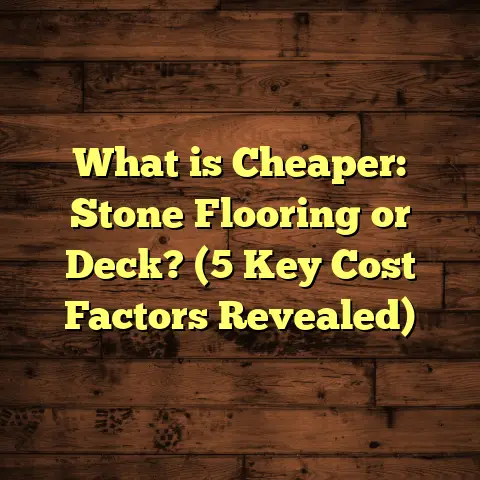What is Floor Pressure? (5 Key Facts You Need to Know!)
Challenging a common misconception about floor pressure
Have you ever thought about how much pressure your floors actually endure? Most people assume floors are just solid surfaces that hold up furniture and foot traffic without much thought. But the truth is, floor pressure is a complex factor that affects not only the durability of your flooring but also comfort, safety, and long-term performance. I used to think floor pressure was just about standing weight until I encountered a project where ignoring it led to costly repairs. That experience changed my entire approach to flooring projects.
It’s easy to overlook something as subtle as pressure distribution underfoot or beneath furniture. But this invisible force quietly shapes how floors perform day after day. Before we get into the nuts and bolts, I want to share a story from my own work that brought this reality home.
A few years back, I was called into a newly renovated home where the owner had installed beautiful hardwood floors. The problem? After just a few months, there were visible indentations and uneven wear near the living room couch and dining chairs. At first glance, everything looked fine, but when I dug in, it became clear: the heavy furniture legs were concentrating too much pressure on small points. The floors weren’t prepared for this kind of stress without proper protection.
That moment helped me realize that “floor pressure” isn’t just a technical term—it’s a crucial part of how floors behave in real life. So, what exactly is floor pressure? And why should you care? Let’s break it down.
What is Floor Pressure?
When I first heard the term “floor pressure,” I assumed it was just about how much weight a floor can hold. But it’s more specific than that. Floor pressure refers to the force applied per unit area on the floor surface. Think of it like this: if you have a 200-pound person standing on a 2-square-foot area, the pressure on that floor is less than if they were standing on one square foot.
Pressure is measured in pounds per square inch (PSI) or pascals (Pa). PSI is more common in the US for flooring discussions, while pascals are used internationally.
To give you an image, imagine pressing your fingertip against a table. The force your finger applies is concentrated over a tiny area—so the pressure is high at that point even if your overall weight is low. Floors experience similar forces constantly—from people walking and running to furniture and appliances.
Here’s a quick breakdown:
- Force (Weight): The total downward load applied.
- Area: The surface over which this force spreads.
- Pressure: Force divided by area.
This means two objects with the same weight can exert very different pressures depending on how their weight is distributed.
How I Came to Understand Floor Pressure’s Importance
When I started working as a flooring contractor, my focus was mostly on aesthetics and durability ratings. I’d talk about scratch resistance or water damage but rarely gave much thought to how pressure affected things on such a granular level.
One project changed that mindset. A client had installed engineered hardwood throughout their home but kept noticing dents and warping near heavy furniture areas. I inspected the site and tested the flooring’s PSI tolerance versus the point loads created by furniture legs.
Turns out, they hadn’t used protective pads or distributed the load properly. The concentrated pressure was causing microscopic damage that spread over time. Fixing this required replacing sections of flooring and educating the client on how to manage floor pressure going forward.
That project made me realize: understanding floor pressure isn’t just about preventing dents; it’s about extending flooring lifespan and avoiding costly repairs.
5 Key Facts About Floor Pressure You Need to Know
1. Different Flooring Materials Handle Pressure Differently
If you’re choosing flooring for your home or business, one of the most important things to understand is how different materials tolerate pressure. Not all floors are created equal in this respect.
Here’s a detailed look at some popular flooring types and their typical PSI tolerances:
| Flooring Type | Typical Pressure Tolerance (PSI) | Notes |
|---|---|---|
| Hardwood | 3,000 – 5,000 | Strong but can dent under heavy point loads; moisture affects durability |
| Engineered Hardwood | 2,500 – 4,000 | Slightly less tolerant than solid hardwood due to layered construction |
| Laminate | 1,500 – 2,500 | Susceptible to dents; depends heavily on quality of top wear layer |
| Vinyl | 1,000 – 2,000 | Good for light to moderate loads; softer surface can show indentations |
| Ceramic Tile | 4,000 – 6,000 | Very high tolerance but brittle; substrate quality critical for structural support |
| Carpet | 500 – 1,000 | Low PSI tolerance; pressure causes flattening and wear spots |
What surprised me was how much moisture content influences hardwood’s PSI tolerance. I read studies showing that when wood’s moisture content rises above 12%, its resistance to indentation drops drastically—sometimes by nearly 40%. This means even the strongest hardwood can become vulnerable under damp conditions combined with heavy pressure.
2. Point Loads are More Damaging Than Distributed Loads
Here’s something most people don’t realize: it’s not just about how heavy something is, but how that weight is spread out.
I remember working on a commercial office where filing cabinets caused damage over time even though they weren’t extremely heavy. The reason? Each cabinet leg focused all the weight into a tiny spot—creating what we call “point loads.”
Point loads cause peaks in pressure that can quickly surpass what the floor can handle in those areas. Distributed loads spread weight over larger surfaces and reduce this risk.
For example:
- A heavy sofa with four wide legs distributes weight better than one with thin metal legs.
- A large rug under furniture spreads load evenly across the floor.
When I install flooring for clients who have heavy furniture or equipment, I always recommend adding protective pads or coasters under legs to avoid these damaging point pressures.
3. Floor Pressure Affects Subfloor and Structural Integrity
Most people focus on the visible floor surface but forget what lies beneath matters too. Floors have multiple layers: finish material, underlayment, subfloor, and structural joists.
Excessive or uneven floor pressure can cause problems beyond dents or scratches—it stresses the subfloor and joists underneath.
I worked on a commercial project where a room filled with heavy machinery started showing signs of uneven floor sagging after only a year. Upon inspection, we found that joist deflection was occurring due to concentrated loads exceeding design capacity.
We had to reinforce joists and improve load distribution to prevent structural failure. This experience taught me floors are more than decoration—they’re structural systems that need to handle forces correctly.
4. Moisture Interacts with Floor Pressure in Harmful Ways
Moisture is an enemy of many flooring types—especially wood-based ones—and when combined with high floor pressure, it accelerates damage.
I once worked with a client who placed large plants on hardwood floors without proper drainage or mats underneath. The constant moisture from watering combined with heavy plant stands caused warping and cupping in affected areas.
Using moisture barriers or mats can help protect floors in such situations by reducing direct contact between water and material under load.
5. Proper Installation Techniques Can Minimize Floor Pressure Damage
How you install your flooring makes a huge difference in how well it handles pressure over time.
For example:
- Floating floors need expansion gaps so they can move slightly without buckling under pressure.
- Using high-quality underlayment cushions impact forces and spreads loads evenly.
- Correct nailing or gluing ensures no weak spots where pressure concentrates.
- Reinforcing subfloors beneath heavy-load zones prevents sagging or cracking.
In one installation I managed, poor nailing left uneven spots that became high-pressure points under sofas. We fixed this by re-installing sections with better fastener placement and adding extra support beneath.
Going Deeper: How Pressure Damages Floors Over Time
Now that you understand what floor pressure is and why it matters, let’s explore how exactly damage happens on a microscopic level.
Floors are made of materials with certain mechanical properties—hardness, elasticity, tensile strength—which determine how they respond to stress.
When pressure exceeds material limits:
- Indentation: Surface fibers compress permanently.
- Cracking: Material fractures under repeated stress.
- Warping: Moisture combined with pressure changes shape.
- Surface Wear: Abrasion worsens where pressure concentrates foot traffic.
Over time, these effects accumulate leading to visible damage like dents, cracks, warping edges, or uneven surfaces.
How Do You Measure Floor Pressure?
Measurement techniques vary depending on context:
- Direct Measurement: Using sensors or mats that detect load distribution (common in industrial settings).
- Calculation: Estimating based on known weights and contact areas.
Here’s an example calculation for your home:
Let’s say you have a leather armchair weighing 150 lbs resting on four legs with each leg touching the floor at 3 square inches: Floor Pressure per Leg=150 lbs4×3 sq.in=15012=12.5 PSI\text{Floor Pressure per Leg} = \frac{150 \text{ lbs}}{4 \times 3 \text{ sq.in}} = \frac{150}{12} = 12.5 \text{ PSI}
You’d then compare this number against your flooring’s tolerance to see if it’s safe.
If the same chair had thin metal legs touching only 1 sq.in each: Pressure=1504×1=1504=37.5 PSI\text{Pressure} = \frac{150}{4 \times 1} = \frac{150}{4} = 37.5 \text{ PSI}
Notice how reducing contact area triples the pressure!
Case Studies That Brought Floor Pressure Into Focus
Case Study 1: Residential Hardwood Flooring Under Heavy Furniture
A family installed solid oak hardwood floors in their living room—a beautiful choice but vulnerable to dents if not cared for properly.
They had a large antique dining table with ornate legs making tiny contact points. Within six months, indentations showed up near each leg.
We added felt pads beneath all legs and placed area rugs under frequently used chairs. After these changes, no further damage occurred in two years of follow-up inspections.
This case showed me how simple adjustments in furniture setup prevent long-term damage from concentrated pressure.
Case Study 2: Commercial Tile Flooring Crack Issues
A retail store installed ceramic tiles rated for high load-bearing capacity due to heavy display racks expected in-store.
Despite specifications, cracks appeared along grout lines near racks after six months.
We found racks were positioned so all their weight rested on narrow tile edges causing point loads beyond tile tolerance. After repositioning racks and reinforcing substrate with backer boards beneath tiles, cracks stopped appearing.
This reinforced my belief that installation planning must consider actual load distribution—not just weight ratings on paper.
Case Study 3: Industrial Vinyl Flooring Under Machinery
An industrial facility used vinyl flooring for chemical resistance and ease of cleaning under heavy manufacturing machines.
Some sections developed wear spots despite vinyl’s general durability.
Adding rubber mats under machine feet redistributed load more evenly and absorbed impact vibrations—extending vinyl life by several years before replacement was needed.
This case demonstrated how combining materials can mitigate floor pressure effects efficiently.
My Top Recommendations for Managing Floor Pressure at Home
From my years working in flooring installation and repair, here are practical tips anyone can apply:
- Use Furniture Pads: Felt or rubber pads under all furniture legs spread out point loads.
- Choose Flooring Wisely: Match flooring type to expected use—don’t put low-tolerance carpet in high-traffic zones.
- Protect High Load Areas: Use rugs or mats under heavy furniture or appliances.
- Control Moisture: Keep floors dry; use moisture barriers especially under wood flooring.
- Regular Inspection: Check for early signs of denting or cracking so repairs can happen before damage spreads.
- Install Correctly: Hire professionals who understand substrate reinforcement and proper fastening techniques.
Advanced Insights: Research About Floor Pressure Effects
I spend a lot of time keeping up with industry research because it helps me recommend better solutions to clients.
Here are some findings from recent studies:
- A study published by the Wood Products Laboratory found that hardwood indentation resistance decreases by as much as 40% when moisture content exceeds 12%. This explains why floors swell or dent more easily during humid seasons.
- Simulation tests show point loads create deflections up to three times greater than evenly distributed loads of equivalent weight. This emphasizes why spreading out furniture legs or using pads prevents damage.
- A research paper from the Flooring Manufacturers Association analyzed failure rates in laminate floors exposed to various PSI levels—higher quality laminates with thicker wear layers performed better under sustained loads exceeding 2,000 PSI.
How FloorTally Helps Calculate Your Floor Installation Costs Considering Pressure
One tool I use often is FloorTally—it’s great for estimating costs but also helps consider factors related to floor pressure:
- It factors in waste percentages which account for extra material needed around high-pressure zones.
- Allows input of different materials so you can compare cost versus durability/pressure tolerance.
- Helps visualize total costs including labor for reinforcement if needed.
Using tools like this early saves headaches later when floor damage appears unexpectedly due to poor planning around pressure concerns.
What Happens When Floor Pressure Is Ignored?
Ignoring floor pressure leads to problems like:
- Dents or indentations under furniture legs
- Cracks in tile or engineered wood planks
- Warping or cupping in hardwood floors due to moisture + weight
- Subfloor sagging or joist damage in extreme cases
- Increased maintenance costs from frequent repairs
I’ve seen clients replace entire sections prematurely because they didn’t factor these forces during selection/installation phases.
Common Myths About Floor Pressure Debunked
Let me clear up some common myths I’ve encountered:
Myth #1: Heavier objects always cause more damage
Not necessarily—it’s how weight is distributed that matters most.
Myth #2: All hardwood floors handle weight equally
Different species and finishes vary widely in PSI tolerance; installation quality also matters.
Myth #3: Using rugs prevents all floor damage
Rugs help but won’t fix underlying structural issues from excessive pressure points or moisture problems underneath.
Myth #4: Only commercial floors need worry about pressure
Residential spaces with heavy furniture or kids running around also suffer from floor pressure effects over time.
How You Can Test Your Floors at Home
Want to get hands-on? Here are simple ways to test how your floors handle pressure:
- Press down on small objects like chair legs or shoe heels and observe any indentations.
- Place protective pads temporarily and see if visible dents disappear over time.
- Use a ruler or caliper tool to measure depth of dents developed under furniture.
These simple assessments help you decide whether upgrades like better underlayment or reinforcement might be needed before bigger damage occurs.
Emerging Trends: Innovations Addressing Floor Pressure Challenges
Here’s some exciting stuff happening now:
- High-Density Composite Underlays: These distribute loads better than traditional foam layers.
- Enhanced Wear Layers: New laminates have tougher surfaces resisting dents even at higher PSI levels.
- Smart Sensors: Some commercial buildings install sensors detecting point loads in real-time to prevent structural overloads.
- Eco-Friendly Reinforcement Materials: Sustainable options like bamboo plywood subfloors provide high strength with less environmental impact.
Keeping an eye on these trends helps me offer clients modern solutions that combine durability with aesthetics perfectly suited for their needs.
Why Understanding Floor Pressure Saves Money Long Term
I’ve noticed clients who invest upfront in proper materials and installation techniques see fewer repairs over time. That means less money spent patching dents or replacing damaged boards later on—often saving thousands over years compared to cheaper initial installs without considering floor pressure implications.
Investing in quality also means peace of mind knowing your floors will maintain their beauty and function despite daily wear from family life or business operations.
Wrapping Up My Thoughts (Without Saying “In Conclusion”)
So here’s what I hope you take away:
Floor pressure isn’t just some technical jargon—it directly impacts how well your floors perform day-to-day and over years. Understanding it means choosing the right materials, installing properly, protecting vulnerable spots, controlling moisture, and knowing when reinforcements are necessary.
If you’re planning new flooring or want advice on protecting existing floors from damage caused by concentrated loads—ask me anytime! I’m happy to help assess your situation and recommend solutions based on real-world experience mixed with data-backed insights.
Have you noticed any indentations or warping in your home floors? Could it be related to floor pressure? Let me know what you’re dealing with—I enjoy solving these puzzles!





